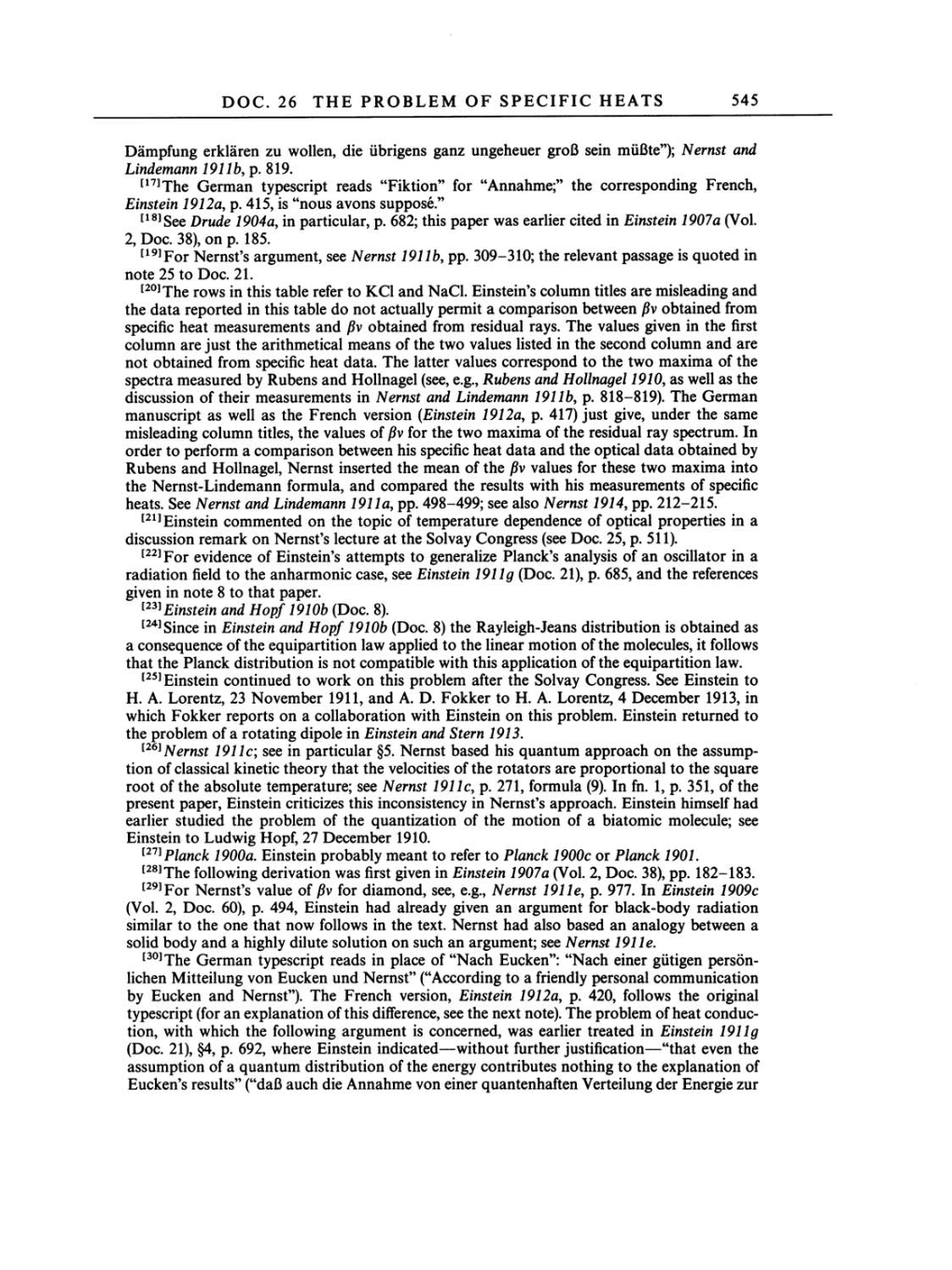DOC.
26
THE
PROBLEM OF SPECIFIC HEATS
545
Dämpfung
erklären
zu wollen,
die
übrigens ganz ungeheuer groß
sein müßte");
Nernst and
Lindemann
1911b, p.
819.
[17]The German
typescript
reads "Fiktion" for
"Annahme;"
the
corresponding French,
Einstein
1912a,
p.
415, is
"nous
avons
suppose."
[18]See
Drude
1904a,
in
particular,
p.
682;
this
paper
was
earlier cited in
Einstein
1907a
(Vol.
2,
Doc.
38), on p.
185.
[19]For
Nernst's
argument,
see
Nernst
1911b, pp.
309-310;
the relevant
passage
is
quoted
in
note 25 to
Doc.
21.
[20]The
rows
in
this table
refer to
KCl and NaCl. Einstein's column titles
are
misleading
and
the
data
reported
in
this table do
not
actually permit
a
comparison
between
ßv
obtained
from
specific
heat
measurements
and
ßv
obtained from residual
rays.
The values
given
in
the
first
column
are
just
the arithmetical
means
of the
two
values listed
in
the second column and
are
not
obtained from
specific
heat data. The latter values
correspond
to
the
two
maxima of
the
spectra
measured
by
Rubens and
Hollnagel (see, e.g.,
Rubens
and
Hollnagel
1910, as
well
as
the
discussion of their
measurements in
Nernst
and Lindemann
1911b, p.
818-819).
The
German
manuscript
as
well
as
the French version
(Einstein 1912a,
p.
417) just give,
under
the
same
misleading
column
titles,
the values of
ßv
for the
two
maxima of
the
residual
ray spectrum.
In
order
to
perform
a
comparison
between
his
specific
heat data and the
optical
data
obtained
by
Rubens and
Hollnagel,
Nernst inserted the
mean
of the
ßv
values for these
two
maxima into
the Nernst-Lindemann
formula,
and
compared
the results with
his
measurements of
specific
heats.
See
Nernst and
Lindemann
1911a, pp.
498-499;
see
also Nernst
1914, pp.
212-215.
[21]Einstein commented
on
the
topic
of
temperature dependence
of
optical properties
in
a
discussion remark
on
Nernst's lecture
at
the
Solvay Congress
(see
Doc.
25,
p. 511).
[22]For evidence of Einstein's
attempts
to
generalize
Planck's
analysis
of
an
oscillator
in
a
radiation field to
the anharmonic
case, see
Einstein
1911g
(Doc. 21), p.
685,
and the
references
given
in note
8
to
that
paper.
[23]Einstein and
Hopf
1910b
(Doc.
8).
[24]Since
in Einstein
and
Hopf
1910b
(Doc.
8)
the
Rayleigh-Jeans
distribution
is
obtained
as
a
consequence
of
the
equipartition
law
applied
to
the linear motion of
the
molecules,
it
follows
that the Planck distribution
is not
compatible
with this
application
of
the
equipartition
law.
[25]Einstein
continued to
work
on
this
problem
after the
Solvay Congress.
See
Einstein
to
H.
A. Lorentz, 23
November
1911,
and
A.
D.
Fokker
to H.
A. Lorentz,
4
December
1913,
in
which Fokker
reports on
a
collaboration with Einstein
on
this
problem.
Einstein returned
to
the
problem
of
a
rotating dipole
in Einstein and
Stern
1913.
[26]Nernst
1911c;
see
in
particular
§5.
Nernst based
his
quantum approach on
the
assump-
tion of
classical
kinetic
theory
that
the
velocities
of
the rotators
are
proportional
to
the
square
root
of the absolute
temperature;
see
Nernst
1911c, p. 271,
formula
(9).
In
fn.
1,
p. 351,
of
the
present paper,
Einstein criticizes this
inconsistency
in
Nernst's
approach.
Einstein himself had
earlier studied the
problem
of the
quantization
of the motion of
a
biatomic
molecule;
see
Einstein
to Ludwig Hopf,
27 December
1910.
[27]Planck
1900a.
Einstein
probably
meant to refer to
Planck
1900c
or
Planck
1901.
[28]The
following
derivation
was
first
given
in
Einstein
1907a
(Vol. 2,
Doc.
38),
pp.
182-183.
[29]For Nernst's value of
ßv
for
diamond,
see,
e.g.,
Nernst
1911e,
p.
977.
In Einstein
1909c
(Vol.
2,
Doc.
60), p.
494,
Einstein had
already
given an
argument
for
black-body
radiation
similar
to
the
one
that
now
follows in
the
text.
Nernst had also based
an analogy
between
a
solid
body
and
a
highly
dilute solution
on
such
an argument; see
Nernst
1911e.
[30]The
German
typescript
reads
in
place
of "Nach Eucken": "Nach einer
gütigen persön-
lichen
Mitteilung
von
Eucken und Nernst"
("According
to
a
friendly personal
communication
by
Eucken and
Nernst").
The French
version,
Einstein
1912a,
p.
420,
follows
the
original
typescript
(for
an explanation
of
this
difference,
see
the
next
note).
The
problem
of heat conduc-
tion,
with which the
following argument is
concerned,
was
earlier treated
in
Einstein 191lg
(Doc. 21),
§4,
p.
692,
where Einstein
indicated-without
further
justification-"that
even
the
assumption
of
a
quantum
distribution of
the
energy
contributes
nothing
to
the
explanation
of
Eucken's results"
("daß
auch
die
Annahme
von
einer
quantenhaften Verteilung
der
Energie
zur
